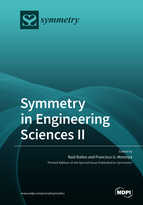Symmetry in Engineering Sciences II
A special issue of Symmetry (ISSN 2073-8994). This special issue belongs to the section "Computer".
Deadline for manuscript submissions: closed (31 January 2020) | Viewed by 68611
Special Issue Editors
Interests: energy economics; renewable energy; power meters; network analysis; engineering optimization
Special Issues, Collections and Topics in MDPI journals
Interests: geometric algebra; power quality; power theory; power engineering; optimization techniques
Special Issues, Collections and Topics in MDPI journals
Special Issue Information
Dear Colleagues,
Symmetry is a frequent pattern widely studied in different research fields. In particular, complex systems with symmetric and asymmetric characteristics arise in engineering science (e.g., in mechanical engineering, symmetric and synchronized systems are often used to satisfy stability criteria for rotating structures; in electrical engineering, the study of symmetrical and asymmetrical faults in power systems is a critical issue; in telecommunications engineering, many systems are symmetrical since data speed or quantity is the same in both directions; in civil engineering, the strength of the objects depends on the symmetry; in computer engineering, symmetric network structures and symmetric algorithms are often studied; etc.).
This Special Issue invites researchers to submit original research papers and review articles related to any engineering discipline in which theoretical or practical issues of symmetry are considered. The topics of interest include (but are not limited to):
- Symmetry in electrical engineering (power, electronics, electromechanics, computer, control, microwaves, telecommunications, etc.);
- Symmetry in mechanical engineering (acoustical, aerospace, automotive, marine, railway, thermal, etc.);
- Symmetry in civil engineering (architectural, construction, earthquake, environmental, hydraulic, mining, structural, transportation, etc.);
- Symmetry in chemical engineering (biochemical, molecular, processes, thermodynamics, etc.);
- Symmetry in other interdisciplinary engineering disciplines (agricultural, biomedical, graphical modelling, industrial, information, materials, metallurgy, military, nanotechnology, control, automation, robotics, etc.);
- Symmetry and topology of complex networks in engineering;
Symmetry and optimization in engineering applications.
Prof. Dr. Raúl Baños Navarro
Prof. Dr. Francisco G. Montoya
Guest Editors
Manuscript Submission Information
Manuscripts should be submitted online at www.mdpi.com by registering and logging in to this website. Once you are registered, click here to go to the submission form. Manuscripts can be submitted until the deadline. All submissions that pass pre-check are peer-reviewed. Accepted papers will be published continuously in the journal (as soon as accepted) and will be listed together on the special issue website. Research articles, review articles as well as short communications are invited. For planned papers, a title and short abstract (about 100 words) can be sent to the Editorial Office for announcement on this website.
Submitted manuscripts should not have been published previously, nor be under consideration for publication elsewhere (except conference proceedings papers). All manuscripts are thoroughly refereed through a single-blind peer-review process. A guide for authors and other relevant information for submission of manuscripts is available on the Instructions for Authors page. Symmetry is an international peer-reviewed open access monthly journal published by MDPI.
Please visit the Instructions for Authors page before submitting a manuscript. The Article Processing Charge (APC) for publication in this open access journal is 2400 CHF (Swiss Francs). Submitted papers should be well formatted and use good English. Authors may use MDPI's English editing service prior to publication or during author revisions.
Keywords
- Symmetry and asymmetry
- Symmetry and synchronization
- Symmetry operations
- Symmetry measures
- Topological symmetry
- Geometric symmetry
- Symmetry in complex systems
- Complex networks and graphs
- Optimization
- Computation
- Electrical engineering
- Mechanical engineering
- Civil engineering
- Chemical engineering







